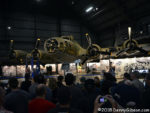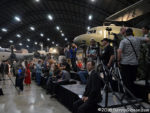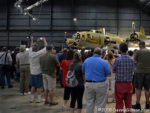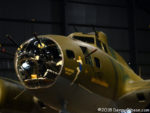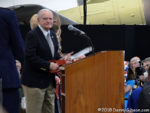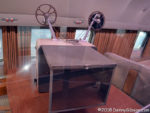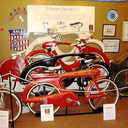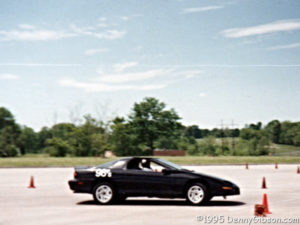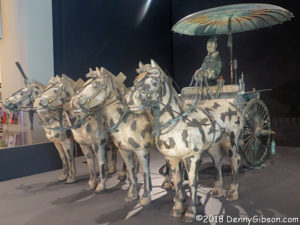 I can’t really explain how the word Qin got turned into China, but it did. Some oriental linguistic transformations, such as Peking to Beijiing, are fairly recent but Qin has been China for a very long time. During a period actually called the Warring States Period, Qin was merely one of the states that warred. But it was better at it than most. In 221 BCE, under the leadership of Ying Zheng, Qin conquered the last of those other states to unify Qin/China. Although the Qin Dynasty was short lived (221-206 BCE) it gave the world its most populous country, biggest wall, and most mind boggling tomb.
I can’t really explain how the word Qin got turned into China, but it did. Some oriental linguistic transformations, such as Peking to Beijiing, are fairly recent but Qin has been China for a very long time. During a period actually called the Warring States Period, Qin was merely one of the states that warred. But it was better at it than most. In 221 BCE, under the leadership of Ying Zheng, Qin conquered the last of those other states to unify Qin/China. Although the Qin Dynasty was short lived (221-206 BCE) it gave the world its most populous country, biggest wall, and most mind boggling tomb.
Construction of that tomb, a 38 square mile complex clearly deserving of the name necropolis, began before China’s unification. Ying Zheng launched the project in 246 BCE after becoming ruler of Qin following his father’s death. He was thirteen. One of the best known of the many astounding aspects of the site is the army of nearly 8,000 life sized terracotta figures populating it. Ten of those figures are among the 120 items currently on display at the Cincinnati Art Museum. The chariot in the opening photograph is a replica of one found at the burial site. It is on display near the museum entrance separate from the actual exhibit.
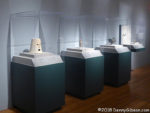
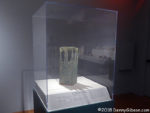
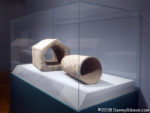 The majority of items in the exhibit are much smaller than those soldiers and some predate the Qin dynasty Many of the smallest are jewelry or other decorative items. A lot of the mid-sized items are more practical. The earthenware mask, believed to have been used by an exorcist, dates from 4000-3000 BCE. The metal cladding in the second picture was used to join construction timbers. The Chinese have long used ceramic tile for roofs and other construction needs. Both items in the third picture are tiles used in water supply systems.
The majority of items in the exhibit are much smaller than those soldiers and some predate the Qin dynasty Many of the smallest are jewelry or other decorative items. A lot of the mid-sized items are more practical. The earthenware mask, believed to have been used by an exorcist, dates from 4000-3000 BCE. The metal cladding in the second picture was used to join construction timbers. The Chinese have long used ceramic tile for roofs and other construction needs. Both items in the third picture are tiles used in water supply systems.
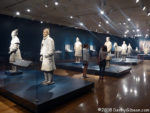 This was the third time I’ve been able to gaze upon some of the twenty-two century old figures. The first was in 1980 at the Field Museum in Chicago; The second just two years later at the 1982 Knoxville World’s Fair. In Chicago, six soldiers and two horses were part of a large “Great Bronze Age of China” exhibit. In Knoxville, two soldiers and a horse accompanied a tiny piece of the Great Wall in China’s first World’s Fair exhibit since 1904. Both were remarkable in that the figures had been discovered just a few years prior in 1976. I find the fact that they were forgotten for more than two millennia as extraordinary as the fact that they existed at all.
This was the third time I’ve been able to gaze upon some of the twenty-two century old figures. The first was in 1980 at the Field Museum in Chicago; The second just two years later at the 1982 Knoxville World’s Fair. In Chicago, six soldiers and two horses were part of a large “Great Bronze Age of China” exhibit. In Knoxville, two soldiers and a horse accompanied a tiny piece of the Great Wall in China’s first World’s Fair exhibit since 1904. Both were remarkable in that the figures had been discovered just a few years prior in 1976. I find the fact that they were forgotten for more than two millennia as extraordinary as the fact that they existed at all.

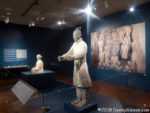 The terracotta army contains a broad range of ranks and duties and every member is unique in some way. This exhibit includes a representative sample ranging from general to stable hand with foot soldiers, a couple of archers, and a charioteer. The cavalryman in the first photo does look like the one whose thumb was broken off in Philadelphia last December by some jerk from Delaware, but it’s not. That set of figures has returned to China. The Cincinnati exhibit was organized by the Cincinnati Art Museum and the Virginia Museum of Fine Arts where it had been displayed until mid-March. Those and other details are found in a press release here.
The terracotta army contains a broad range of ranks and duties and every member is unique in some way. This exhibit includes a representative sample ranging from general to stable hand with foot soldiers, a couple of archers, and a charioteer. The cavalryman in the first photo does look like the one whose thumb was broken off in Philadelphia last December by some jerk from Delaware, but it’s not. That set of figures has returned to China. The Cincinnati exhibit was organized by the Cincinnati Art Museum and the Virginia Museum of Fine Arts where it had been displayed until mid-March. Those and other details are found in a press release here.
Terracotta Army: Legacy of the First Emperor of China runs through August 12.
There is another traveling exhibit at the Cincinnati Art Museum currently. It’s one I failed to do any homework on at all and I regret that — maybe. The main part of the exhibit is called The Visitors which is described as a “multi-channel video installation”. It’s the work of Ragnar Kjartansson. His Scenes from Western Culture is also on display. It’s possible to find descriptions of both of these works elsewhere but this is the only place to get a description of how I experienced them. Lucky you.
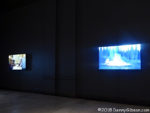 Ragnar Kjartansson’s name was on the entrance to a fairly large room that often holds traveling exhibits with several large video screens on the walls of the approaching hallway. I’d seen the name when visiting the museum website but I hadn’t been interested enough to do any reading and I really had no idea what to expect. I scanned a blurb on the wall about short movies that set a mood rather than telling a story before watching a couple kissing on a dock by a boat and a group of kids playing almost sedately in a park. A screen with a fire burning in what looked like the foundation of a house triggered a memory. I’d recently seen a similarly framed image of a cabin ablaze and realized it must have been on the museum’s website. The blurb next to the screen mentioned a 32 minute running time. I needed to kill some time and the cabin, if that’s what it was, had completely collapsed so maybe it was near the end. I sat down across from the screen to see if it would cycle to the remembered image of a cabin.
Ragnar Kjartansson’s name was on the entrance to a fairly large room that often holds traveling exhibits with several large video screens on the walls of the approaching hallway. I’d seen the name when visiting the museum website but I hadn’t been interested enough to do any reading and I really had no idea what to expect. I scanned a blurb on the wall about short movies that set a mood rather than telling a story before watching a couple kissing on a dock by a boat and a group of kids playing almost sedately in a park. A screen with a fire burning in what looked like the foundation of a house triggered a memory. I’d recently seen a similarly framed image of a cabin ablaze and realized it must have been on the museum’s website. The blurb next to the screen mentioned a 32 minute running time. I needed to kill some time and the cabin, if that’s what it was, had completely collapsed so maybe it was near the end. I sat down across from the screen to see if it would cycle to the remembered image of a cabin.
I checked email and Facebook and verified that City View Tavern, where I planned to eat, was open. The fire was still going pretty good within the outline of the building, so I decided to go on into the main room. Even bigger screens lined those walls with little activity on any of them. I studied each of them briefly then went back to the hallway to check on the “fire”. The flames didn’t hold my attention very long this time and I soon decided to walk on through the main room and exit. A couple of the screens were now dark but the others showed the same motionless scenes as before. As I paused near one of the screens, a man appeared and walked toward the camera. The screen went black when he presumably switched it off. I waited long enough for the same thing to happen to another screen. The pause gave me time to rethink things and realize that I still had time to kill and doing it here was probably my best option. I returned to my seat near the fire video.
I now noticed a blurb on the side if the door away from the “fire”. I learned that the installation inside, The Visitors, involved musicians, in different rooms of a mansion, playing and singing a song. The fire in the video didn’t seem to be progressing much, so, when I heard voices singing on the other side of the doorway, I went in and, for the first time, considered that Ragnar Kjartansson might not be a full on con-artist.
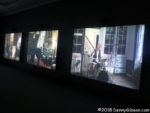
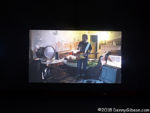 All the screens were lit and all the rooms occupied: a cello, a couple of grand pianos, an accordion, a banjo, several guitars. The show — I mean installation — had become interesting. Though the music wasn’t gripping, it was quite pleasant. It swelled and softened. In some of the mellowest spots, the drummer sipped a beer. After a while I noticed the bare shoulders of a young woman lying in the bed one of the guitarist sat on. The run time was given as 64 minutes, and, as far as I know, she didn’t move for the entire shoot. If so, that’s almost as impressive as her roommate contributing to the performance guided only by earphones.
All the screens were lit and all the rooms occupied: a cello, a couple of grand pianos, an accordion, a banjo, several guitars. The show — I mean installation — had become interesting. Though the music wasn’t gripping, it was quite pleasant. It swelled and softened. In some of the mellowest spots, the drummer sipped a beer. After a while I noticed the bare shoulders of a young woman lying in the bed one of the guitarist sat on. The run time was given as 64 minutes, and, as far as I know, she didn’t move for the entire shoot. If so, that’s almost as impressive as her roommate contributing to the performance guided only by earphones.
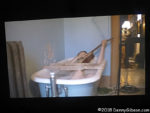 The museum is free and so is this. I’m really thinking of returning to watch the whole thing in the proper sequence now that I know what’s going on. Through some belated homework, I learned that Ragnar’s the guy in the bathtub. A quite remarkable selfie.
The museum is free and so is this. I’m really thinking of returning to watch the whole thing in the proper sequence now that I know what’s going on. Through some belated homework, I learned that Ragnar’s the guy in the bathtub. A quite remarkable selfie.
The Visitors and Scenes from Western Culture run through June 17.




